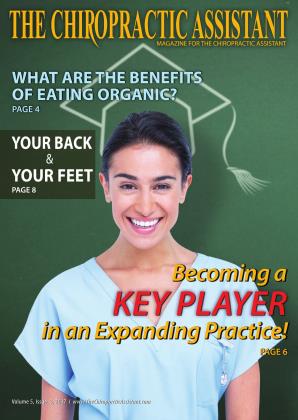The Broadening of chiropractic and Its Effect on Paraprofessionals
By Cole Hosenfeld, DC, DACBSP
Since its inception in 1895, the chiropractic profession has taken many twists and turns to grow and reach more of the populace in the pursuit of improved care. As with any strain, new ideas and concepts have birthed from this growth. Like most healing arts, chiropractic has broadened its interests to various focused areas of healing and treatment. The definition of broadening is "to expand to encompass more people, ideas, or things." Examples of this expansion are chiropractic postdoctoral specialties ranging from radiology, nutrition, orthopedics, neurology, and sports medicine to advanced training in various adjustment techniques and structural biomechanics correction approaches, such as upper cervical specific and chiropractic biophysics, to name a few.
In the opinion of many, paraprofessionals are key players to help the chiropractic profession progress. As chiropractors expand and broaden their education and discipline focus, so do the profession's assistants. Paraprofessionals work side by side with chiropractic physicians to deliver quality care to the marketplace. Examples of these professionals include administrative chiropractic assistants who focus on excellence in the area of practice management, such as front desk and billing. As the complexity of third-party payers increases and the convenience mind-set of Americans
demands "more value for less," the need to engage the patient with intelligence, focus, and compassion has arguably never been more important.
Over the past 17 years, chiropractic's expanding interest brought training certification of clinical therapy assistants to the scene. This state-by-state initiative is still in the developing stages in many states and with minimal guidelines created by the Federation of Chiropractic Licensing Boards (FCLB), national perspectives are being considered. Essentially, this certification and/or licensure educates the chiropractic assistant at a higher level in anatomy/physiology, chiropractic techniques, physiotherapy procedures and protocols, exercise rehabilitation, examination techniques, X-ray, and areas of risk management, along with education about the various disorders and diseases the chiropractor commonly treats.
Through the convenience model of healthcare education and need to be cost-conscious, distance-learning models have been developed. In my home state of Tennessee, the state began licensing chiropractic therapy assistants in 2000 and created an education model in anticipation of this broadening trend. The certification requires a 50-hour distance-learning course focusing on the area of clinical treatment and
The impact of this advancement on the profession has been seen especially in the areas of retention of I patients and staff.”
therapy through textbook, workbook, DVD education, testing, and 1,200 hours of on-site apprenticeship hours under the practicing chiropractor. Having served as a model for the FCLB's certified chiropractic clinical assistant, the chiropractic therapy assistant program is approved education for their examination, is PACE approved, and is now utilized at a national level by numerous organizations.
In addition, my state requires those assistants who want to be licensed to take X-rays to go through a radiologic-specific 48-hour training. This training may be completed over multiple weekends, also accompanied by testing and 1,040 hours of apprenticeship prior to state licensure. The beauty of this method of training is the ability of paraprofessionals to further their education while maintaining a quality of living. While hours, titles, and criteria may vary slightly across the states, standardized education is critical to strengthen the chiropractic profession, provide high-quality of care for patients, and empower staff to become professionals in their field.
The greatest resistance throughout the initial development stages of these advanced training programs came from practicing doctors and was related to the need for increased wage reimbursement to the profession's assistants. The concern is mainly around diminishing healthcare dollar returns among thirdparty payers across disciplines. However, after 17 years in place, these paraprofessionals have helped improve care delivery with increased knowledge and competence, and the state's chiropractors have been pleased. The impact of this advancement on the profession has been seen especially in the areas of retention of patients and staff.
As evidence-based care evolves and guidelines continue to develop, the population at large and thirdparty payers are continuing to demand professional, ethical, and effective measures of healthcare delivery. Additionally, improved collaboration between disciplines is sought as evidenced by the emergence over the past decade of integrative clinics and practice models, in an effort to provide a more thorough care paradigm for the patient.
For those who may be new to the role of chiropractic assistant or considering additional training, you have the opportunity to benefit from the advances made in CA education. For those of you who have proactively sought clinical education to increase your professionalism, you are a part of this movement. As leaders in your field, you serve as critical advocates not only for your practice, but also for chiropractic care as a whole. The broadening of a profession is a natural progression of any healthcare discipline that seeks to refine and hold itself accountable to the growing and aging population. As our profession broadens, we must look beyond the doctor and realize that our healthcare team is the backbone of our practices, and their continued training must be a focus in order to deliver high-quality, cost-effective health care that is accessible, competent, and value-added. When we support our team, our team supports us, and the patient will always take notice and reap the benefits.
Cole Hosenfeld, DC, DACBSP, practices in Knoxville, Tennessee. He is board certified in sports medicine and practices in an integrative setting with a team of paraprofessionals. He sits on Tennessee’s regulatory board and is coauthor of the textbook Chiropractic Therapy Assistant: A Clinical Resource Guide. Additional information on this text may befound atwww.ctaprogiam.com online. He can be reached by e-mail at [email protected].
 View Full Issue
View Full Issue







